December 2009
Monthly Archive
Sat 5 Dec 2009
Reviewed by DAVID L. VINEYARD:
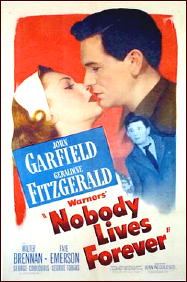
NOBODY LIVES FOREVER. Warner Brothers, 1946. John Garfield, Geraldine Fitzgerald, Walter Brennan, Faye Emerson, George Tobias, George Coulouris. Screenplay by W.R. Burnett, based his novel. Director: Jean Negulesco.
When Nick Blake (John Garfield “People like me don’t change.”) comes back to New York from the war he finds his girlfriend night club singer Tony Blackburn (Faye Emerson who has a nice number, “You Again” in the club) has double crossed him and given the $50,000 he left with her to her boyfriend. Nick gets the money back and heads to Los Angeles with the $50k for seed money with his pal Al Doyle (George Tobias) to take up his old life of con man.
Once he reaches L.A. Nick meets another old con, Pop Gruber (Walter Brennan), who tells him about Gladys Halvorsen (Geraldine Fitzgerald) a widow with two million dollars and Nick sets out to woo her, win her, and fleece her, but he finds he is falling for her, and when he tries to back out of the con runs afoul of one time partner Doc Ganson (George Coulouris) and ends up having to rescue the kidnapped Gladys after a number of well handled plot twists and Blake’s struggle with his unexpected reform.

The slick little exercise in romantic noir is a neglected little gem from both Burnett and director Negulesco. Brennan and Tobias are scene stealers as usual, Fitzgerald gets a rare chance to shine as a romantic lead, and Garfield gets a showcase for his tough but tender screen persona.
Coulouris had a long colorful career in such bad guy roles (he was still at it as late as the Lord Peter Wimsey adaptation of Clouds of Witness, where he plays a murderous farmer), and gets to shine here. Emerson has a nice turn as a none too honest blonde bombshell who sets up a nice contrast with Fitzgerald later in the film.
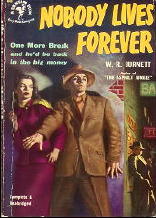
The film is true to the book, as might be expected, since Burnett wrote both, but Garfield can’t help but bring a layer of vulnerability to Nick that may not be as obvious on the printed page, and Brennan makes the most of Pop Gruber (you have to wonder if this is a nod to Frank Gruber with whom Burnett sometimes collaborated on screenplays).
Nobody Lives Forever isn’t major noir, but it is an attractive and well done little film that delivers what it promises, with an outstanding cast that never falters or missteps.
It may be noir in a minor key, but nary a false note is struck, and at 100 minutes the film is lean and stripped down, yet has time to develop character and a plot that has some nice touches, such as a scene in which Cole Porter’s “Don’t Fence Me In” plays on a juke box in the bar in counterpoint to Nick’s internal debate.
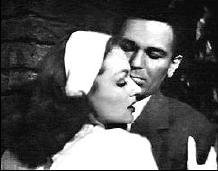
Humphrey Bogart allegedly turned the role of Nick Blake down. Just as well, it fits Garfield’s persona like a glove.
This isn’t a great film, but it is an example of the kind of intelligent and entertaining fare the studios used to turn out with surprising regularity. Like Jules Dassin’s Two Smart People, it’s well made and stands on its own merits.
It’s one of those films that succeed so well at what it sets out to do that you may have to watch it a second time to recognize just how artfully it is constructed and played.
Sat 5 Dec 2009
REVIEWED BY WALTER ALBERT:
THE CARDBOARD LOVER. Cosmopolitan/MGM, 1928. Marion Davies, Nils Asther, Jetta Goudal, Andres De Segurola. Screenplay: F. Hugh Herbert, based on the play Dans sa candeur naive by Jacques Deval. Director: Robert Z. Leonard. Shown at Cinecon 40, Hollywood CA, September 2004.
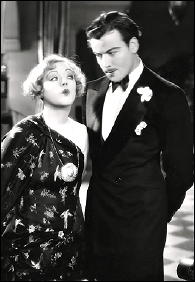
A comedy to be classed with Davies’ performances in The Patsy and Show People. For much of her silent film career, Davies starred in costume dramas that her long-time lover William Randolph Hearst fancied.
Her native gift, however, was for comedy and she established herself as a first-rate comic actress in the comedies that showcase her undeniable talent.
In The Cardboard Lover she’s a vacationing American tourist who collects autographs and in the process of trying to snare the autograph of tennis star Asther (in photo) she becomes infatuated with him and sets out to separate him from the stylish vamp (Goudal) who’s been toying with his affections.
Davies gets a chance to display her skill at impersonation when she does a dead-on imitation of Goudal’s slinky vamp and Asther, not noted as a comic actor, is a charming foil, caught between the two women, while Goudal, for much of the film, ably counters Davies’ moves with her not inconsiderable wiles.
One of the delights of this year’s screenings and a major addition to Davies’ filmography, apparently copied from the sole surviving print.
Fri 4 Dec 2009
A 1001 MIDNIGHTS Review
by Ed Gorman & Bill Pronzini:
W. R. BURNETT – Little Caesar. Alfred A. Knopf, hardcover, 1929. Paperback reprints include: Avon #329, 1951; Bantam Giant A1871, 1959; Signet, 1972. Film: First National, 1931 (with Edward G. Robinson, Douglas Fairbanks Jr., Glenda Farrell; director: Mervyn LeRoy).
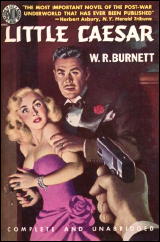
“Mother of God, is this the end of Rico?”
Few movie lines have endured as long and as well as the signature line of Burnett’s Little Caesar screenplay. He ended the novel on which the movie was based with virtually the same line. Burnett mastered an idiom and rhythm that, while essentially literary, spoke directly to the masses.
Caesar is serious and detailed, charting the rise and fall of a Chicago gangster against a backdrop of political and social turmoil. As in his other great novel, High Sierra, Burnett means to treat his headline subject with novelistic scrutiny.
In a bittersweet interview given near the end of his life, Burnett complained that he was often praised for his “plotting,” a compliment he refused on the grounds that he never plotted, but let his characters carry the story to its own organic end.
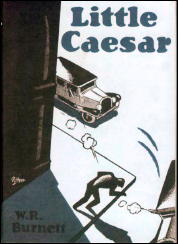
To a large degree, Burnett was correct. In some parts, Little Caesar is a novel of manners, and the overriding concern is not for the story per se but rather how certain events affect the characters who weave in and oat of the book.
Little Caesar is too often used as a bludgeon with which to decimate The Godfather. The books should not be compared. Mario Puzo wrote a fine romance, perhaps a novel of the first rank, after all. Burnett, however, wrote a treatise that was part sociology, part character sketch, part comedy and most of all, a naturalistic reflection of the squalid Chicago slums of the time.
Caesar remains fresh, potent, funny, tragic. Rico, its center, like an great characters, eludes final understanding.
The 1930 film version with Edward G. Robinson and Douglas Fairbanks Jr. is likewise a classic. Robinson’s portrayal of Rico has often been imitated (by himself as well as others, notably in his role in Key Largo) but never surpassed.
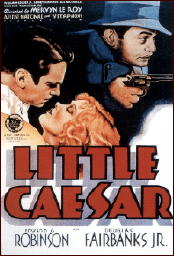
Burnett’s other major crime novel is The Asphalt Jungle (1949), the film version of which — starring Sterling Hayden and Sam Jaffe — has been called “the gangster film of the Fifties.”
Minor but excellent novels are Dark Hazard (1933), The Quick Brown Fox (1942), and Vanity Row (1952). Among Burnett’s numerous screenplays are those for This Gun for Hire (1941) and the 1955 remake of High Sierra starring Jack Palance, I Died a Thousand Times.
———
Reprinted with permission from 1001 Midnights, edited by Bill Pronzini & Marcia Muller and published by The Battered Silicon Dispatch Box, 2007. Copyright © 1986, 2007 by the Pronzini-Muller Family Trust.
Editorial Comment: Novels by W. R. Burnett previously reviewed on this blog, both by Dan Stumpf, are Dark Hazard and Romelle.
In his comment following the former, David Vineyard suggests that while “Burnett is seldom ranked with Hammett, Chandler, and Cain […] at times he was their equal, and I think sometimes surpassed Cain.” He goes on to say that “… maybe that holy trinity of the hard boiled school should be a quartet.”
I can’t quarrel with the sentiment, but the fact is, barely no one remembers Burnett today (and Cain is slipping fast). But this fact, if true, leads to the immediate question:
Can you think of another author as outshadowed as Burnett by the films based on the novels he wrote? The films are seared into the memories of everyone who’s watched them, but how many of those who’ve seen the movies have any idea who wrote the books?
Fri 4 Dec 2009
Posted by Steve under
Reviews[3] Comments
REVIEWED BY DAN STUMPF:
W. R. BURNETT – High Sierra. Alfred A. Knopf, hardcover, 1940. Paperback reprints include: Bantam #826, 1950; Carroll & Graf, December 1986; Zebra, November 1987.
Films: Film: First National, 1941 (with Ida Lupino, Humphrey Bogart; director: Raoul Walsh). Also: Warner Bros., 1949, as Colorado Territory (with Joel McCrea, Virginia Mayo; director: Raoul Walsh). Also: Warner Bros., 1955, as I Died a Thousand Times (with Jack Palance, Shelley Winters; director: Stuart Heisler).
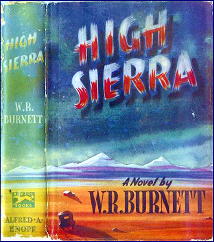
“Early in the twentieth century, when Roy Earle was a happy boy on an Indiana farm, he had no idea that at thirty-seven he’d be a pardoned ex-convict driving alone through the Nevada-California desert towards an ambiguous destiny in the Far West.”
Thus begins what is, in effect, the biography of Roy Earle, a fictional creation who reflects the lives of several eminent American outlaws of the 1920s and 1930s.
The structure and texture of the opening sentence signals the reader that this will be much more than simply a genre piece of tommy guns and molls. Burnett will attempt nothing less than a definitive appraisal of a bandit’s life as Earle leaves prison, falls in love, and works toward the robbery that will doom him.
For many, Sierra is probably more familiar as the finest of Bogart’s films (with the arguable exception of The Treasure of Sierra Madre). In the film version, John Huston sought to create a romance, a complex variation on the Robin Hood myth, but Burnett creates a novelistic portrait of Roy Earle that is full of fire and contradiction.
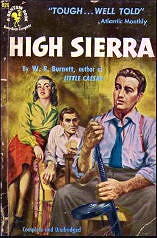
Chapter 37 is the key scene in the book. In the space of 3000 words, Roy Earle expounds on himself (?I steal and I admit it”); on his inability to trust (?The biggest rat we had in prison was a preacher who’d gypped his congregation out of the dough he was supposed to build a church with.”); and on the failure of the common man to fight for himself (?Why don’t all them people who haven’t got any dough get together and take the dough? It’s a cinch.”).
He is, throughout the novel, idealistic, naIve, ruthless, and doomed in a way that is almost lyrical. Not unlike Studs Lonigan, Roy Earle becomes sympathetic because his faults, for all their outsize proportion, are human and understandable, and his humility almost Christ-like. “Barmy used to talk to me about earthquakes,” Roy says; “he said the old earth just twitched its skin like a dog. We’re the fleas, I guess.”
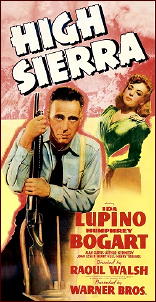
Far from the myths created by J. Edgar Hoover’s biased attitude toward the criminals of the 1930s, Burnett gives us a sad, sometimes surreal look at a true outlaw. High Sierra is filled with every possible kind of feeling, from bleak humor to a pity that becomes Roy Earle’s doom.
The book’s theme of time and fate is worthy of Proust. If you want to know what made the work of “proletariat” America so powerful in the 1930s, all you have to do is pick up this novel.
———
Reprinted with permission from 1001 Midnights, edited by Bill Pronzini & Marcia Muller and published by The Battered Silicon Dispatch Box, 2007. Copyright ? 1986, 2007 by the Pronzini-Muller Family Trust.
Fri 4 Dec 2009
REVIEWED BY GEOFF BRADLEY:
LAW AND ORDER. BBC, 4-part mini-series, 6 April through 27 April 1978. Peter Dean, Derek Martin, Deirdre Costello, Billy Cornelius, Alan Ford, Ken Campbell, Fred Haggerty. Screenplay: G. F. Newman. Director: Les Blair.
Not the long-running Dick Wolf series or one of its spin-offs, this was a British four-part series from 1978. Back then I had no video recorder, and I had a sort of method for screening tv programmes of not watching new ones but waiting to read reviews and then catching them on the repeats.
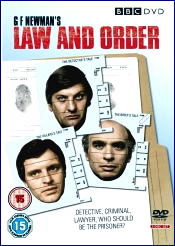
When this series aired there was such a furor of complaints that the series was, to the best of my knowledge, never repeated, leaving me to regret my selection methods.
Now thirty-one years later we have had a repeat on BBC 4, the BBC’s least watched digital channel.
The series was written by G.F. Newman, a man who has developed a reputation as an anti-establishment figure (and the man behind the more recent and upmarket Judge John Deed).
In the first story, “A Detective’s Tale” we meet London D.L Fred Pyle, a sly, mix-with-the-criminals type of detective, who is seen taking a sizable bribe from a major villain to look the other way. Pyle hears from an informant that Jack Lynn, a career criminal, is about to stage an armed robbery and makes it his job to catch him.
In the second episode, “A Villain’s Tale” the focus starts on Lynn as he sets up his armed robbery, however, soon, he suspects that the police are on to him and abandons the prospect. Meanwhile four other criminals stage an armed robbery and when three of them are caught, Pyle plants evidence that Lynn is the fourth man.
In the third episode, “A Brief’s Tale”, we follow the legal system, firstly Lynn’s solicitor, whom we see given secrets to the police for return favours, and then the barrister he employs. The barrister is more concerned with how much money he will make but does actually put on a spirited defence until the judge, outraged by the barrister implying police corruption, forbids him from pursuing that line of defence.
It is no surprise when the three guilty villains are found not guilty but Lynn, a career criminal but entirely innocent of this offence, is found guilty.
In the final part, “A Prisoner’s Tale”, we see Lynn, a proud and angry man, as he tries to resist the prison system but is forced to compliance through bent and violent prison guards, incompetent and uncaring officials, and the system. This is by far the bleakest of the four programmes — and that’s saying something — and it leaves one with a feeling of helplessness.
Of course it’s probable that the system is not as bad as Newman is making out, but it seems likely that some corruption of the kinds he indicates is inevitable. This is a powerful if depressing series, and I’m pleased that finally I have been given a second chance to see it.
Thu 3 Dec 2009
Reviewed by MIKE DENNIS:
HEY, MISTER. GIVE A GIRL A LIFT?
DETOUR. PRC, 1945. Tom Neal, Ann Savage, Claudia Drake, Edmund MacDonald, Tim Ryan. Story & screenplay: Martin Goldsmith. Director: Edgar G. Ulmer.
I hadn’t seen the movie Detour for quite some time, so I pulled it out the other night and gave it a look. And I’m glad I did. It’s even better than I remembered it.
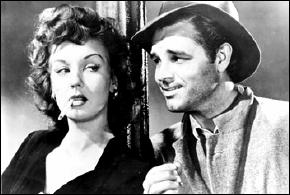
For those who are unfamiliar with this 1945 classic film noir (and I hope there aren’t too many), it’s all told in flashback by an unshaven, despondent Tom Neal, who laments everything that has happened to him in recent weeks.
All he wanted was to hitchhike from New York to Los Angeles to be with his cutesy-poo girlfriend who was trying to “make it in pictures,” but wound up slinging hash instead. That’s all he wanted.
But what he got was Ann Savage. I’ll just leave it at that.
Detour was directed by Edgar G Ulmer, and was made at PRC (Producers Releasing Corporation) Studio, the last stop on poverty row in 1940s Hollywood. Filmed in six days on a budget of $30,000, and using the cheapest sets and production values imaginable, Ulmer crafted a haunting tale of people at the bottom of society’s pyramid. To put this budget into perspective, Avatar, the new James Cameron bloatbuster, cost 10,000 times as much.
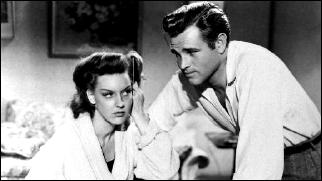
Drowning in desperation, the characters try to hold on to what they have, and never seem to have enough.
When these people are confronted with extraordinary circumstances and emotions, they, like all of us, will alter their mode of behavior. Some will even cross the line, the line that separates legal from criminal, moral from immoral, good from evil, Tom Neal from Ann Savage.
Film noir is generally associated with sinister characters moving through shadowy lighting. Much of Detour takes place under bright light: sunny rides in an open convertible, a well-lit apartment, and so on, but Ulmer’s direction and the interplay between the two leads give the film a very claustrophobic feel, like it was shot in a phone booth. The relentlessly grim story line follows Neal’s character as his life spirals ever downward to the unusual finale.
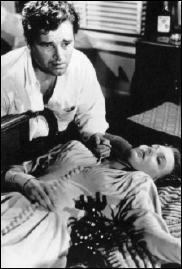
While Detour might be considered classic crime fiction, it’s important to note that no crime was ever committed during the movie.
There’s a scene where Neal takes money and clothes from a dead man, but you know that if he didn’t take the dough, the cops would when they found him. I don’t put that in the crime category.
This is definitely a movie that’s worth another look, noir fans. A great story, with both Neal and Savage delivering unforgettable performances in what has to be the finest hour for each of them.
And if you haven’t seen it, by all means buy it. You can get it online for six or seven dollars. You won’t be sorry.
And you�ll never pick up another hitchhiker again.
Copyright � 2009 by Mike Dennis.
Thu 3 Dec 2009
A TV Movie Review by MIKE TOONEY:
BIRDS OF PREY. ABC, made for TV movie; first telecast: 30 January 1973. David Janssen, Ralph Meeker, Elayne Heilveil, Harry Klekas, Sam Dawson, James W. Gavin, Paul Grace, Wayne D. Wilkinson, Larry Peacey. Aerial supervisor: James W. Gavin; director: William A. Graham.
The first and only time I saw Birds of Prey was thirty-seven years ago, and it blew me away. As action films go, I still think it’s superior to many; and the fact that it was made for television on a minimal budget makes it even more remarkable.
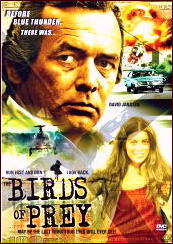
David Janssen plays an ex-World War Two Flying Tigers fighter pilot whose aviation career is winding down; he’s now relegated to being a traffic reporter flying over Salt Lake City, and he’s quietly going nuts from boredom.
One day he happens to observe a bank robbery in progress, which he duly reports to his good pal from the war (Ralph Meeker), who is now a police captain with the Salt Lake City PD. But Meeker doesn’t believe him at first, thinking it’s another one of Janssen’s middle-aged pranks.
That’s all it takes: Janssen sees it as a challenge — and the chase is on. From this point forward, the film is indeed one giant chase sequence. The bad guys transfer themselves, their loot, and a hostage to a helicopter only to be relentlessly harried by Janssen every step of the way. The pacing is terrific.
In addition to two good performances from Janssen (settling into his world-weary “Harry O” character) and Meeker, the helicopters are also the stars. This was long before CGI (computer-generated visual effects); when the choppers swoop under freeway overpasses with a foot or less separating the rotor blades from the concrete abutments, it’s the real thing.
Another amazing sequence happens INSIDE an aircraft hanger, when Janssen corners the bad guys’ copter; this needs to be seen to be believed. The margin for error, with both copters swaying uncertainly in a Mexican standoff, has to be two or three inches at most.
Kudos to the late James W. Gavin for these sequences. Whenever Hollywood needed a master pilot who could also deliver lines in an acceptable fashion, Gavin was their go-to guy. He did lots of screen work in films and TV series such as Adam 12.
If you really get into the characters in this film — as I did — then the final line will be especially poignant: “Damn you, Walker! I didn’t ask you to do that!”
Tech note: If I remember it correctly, Janssen’s chopper was a Hughes 500D, while the criminals had an Aerospatiale Alouette — but it has been almost four decades.
Further note: Birds of Prey is available on video, but many customers complain that the Second World War-era Big Band music featured in the film’s network broadcast — music that is integral and meaningful to the two lead characters — has been replaced with something different, so be aware that you’re not getting the original film.
Thu 3 Dec 2009
REVIEWED BY WALTER ALBERT:
TRANSATLANTIC. Fox, 1931. Edmund Lowe, Greta Nissen, John Halliday, Myrna Loy, Jean Hersholt, Lois Moran, Billy Bevan. Story: Guy Bolton; photography: James Wong Howe. Director: William K. Howard. Shown at Cinecon 40, Hollywood CA, September 2004.
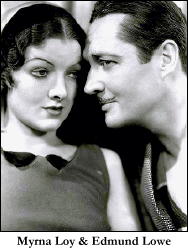
Another rough print (the program notes warned of this) and hardly of the interest of The Letter (reviewed here ) this “Grand Hotel on an ocean liner” (as the notes more or less put it) was an entertaining trifle, owing to a good cast, some fine photography by James Wong Howe, and a serviceable, melodramatic story.
Edmund Lowe is a gent of dubious moral values who’s skipping out of the country but who ironically finds himself becoming the moral center of a series of little dramas, shot through with crime and attempted murder.
The most striking part of the film is a climactic chase up and down and around the massive structures of the ship’s boiler room. A really nice print of this might show off the film to better advantage but I’m not convinced that it has (as the program notes claim) “all the ingredients for one of the greats!”
N. B.: Charlie Shibuk commented to me that he saw the screening of a beautiful 35mm print some 15 years ago at the Museum of Modern Art, and he still agrees with my summation.
Wed 2 Dec 2009
Posted by Steve under
Reviews[4] Comments
A REVIEW BY MARYELL CLEARY:
JUNE THOMSON – Not One of Us. Harper & Row, US, hardcover, 1971. UK edition: Constable, hc, 1972.
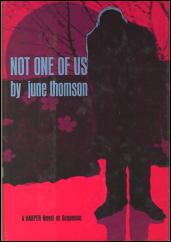
This is an early Thomson, one which displays well her ability to write a quiet, underplayed story of murder, while at the same time delving into the character of those in major roles. John Smith is a “man of mystery,” a retiring, educated Englishman who lives alone in a cottage on the edge of a village.
The villagers are suspicious of anyone who is reclusive, and Smith will not play the good fellow with them. He is happy to live alone with his dog. Then the body of a fifteen year old girl from a neighboring village is found in a wood I not far from Smith’s cottage. She has been strangled, and the autopsy shows that she is six months pregnant.
Inspector Finch suspects Smith, and yet feels that he and Smith have something in common. Gradually Smith’s background is revealed, as the villagers grow more and more hostile. There is subtlety in Thomson’s handling of character.
Finch is changed by his encounter with Smith; so is Smith. We may hope that the people of the village also are changed, but we’re given no reason to believe so.
– Reprinted from The Poisoned Pen, Vol. 6, No. 4, Fall 1986.
Editorial Comment: Inspector Finch was renamed Inspector Rudd for most of June Thomson’s books when they appeared in the US — there being another Inspector Finch who appeared in Margaret Erskine‘s books. This being the first in the series, it’s interesting to see that Finch remained Finch in this one.
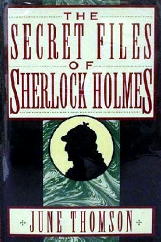
There are now twenty books in the Finch/Rudd series, the most recent being Going Home (2006). As the author is now 79, it is possible that this will also be the last.
Over the past several years, June Thomson has also been writing collections of Sherlock Holmes pastiches, the first of these being The Secret Files of Sherlock Holmes (1990). There are now six books of these, the first few of which I own but (alas) have yet to read.
Whenever a discussion of current and latter-day authors who write in the Golden Age tradition breaks out, for some reason June Thomson’s name seldom comes up, and I think it should.
Wed 2 Dec 2009
Posted by Steve under
Reviews[2] Comments
JANE HADDAM – Quoth the Raven.
Bantam, paperback original; 1st printing, September 1991.
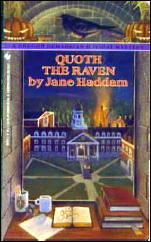
This is the fourth “holiday” adventure of retired FBI agent Gregor Damarkian, the holiday this time around being Halloween. Location: a small school called Independence College, somewhere in southeastern Pennsylvania.
As someone wiser and far more knowledgeable once told me, the reason academic politics are conducted so fiercely is that the stakes are so low. The victim is obvious from the word go: an obnoxious new professor with ambitions of becoming a new Program Head.
But small surprises are in store. First of all, he’s not the first victim. Before that happens, a woman in the college cafeteria line is poisoned to death — with lye. Since the only item on her tray is a cup of tea, this is a puzzler. As Gregor knows fully well, lye fizzes on contact with any form of water. It couldn’t be an accident, but who’d want to harm a mere secretary?
Haddam is a perceptive writer who makes many wickedly sharp observations along the way, and yet the incident above occurs on page 94 and for the next 150 pages, very little seems to happen.
What it all amounts to, in the end, is that this small bizarre mystery is far too intense to be entertaining, and the one small element of the impossible is just too fragile a base to support the grand total of 276 pages of high angst that otherwise prevails.
Not recommended, unless you’re in an offbeat sort of mood anyway.
– This review first appeared in
Deadly Pleasures, Vol. 1, No. 2, Summer 1993 (very slightly revised).
Editorial Comment: Reviewed here by me earlier on this blog was Cheating at Solitaire (2008), also a case for Gregor Demarkian.
« Previous Page — Next Page »


















